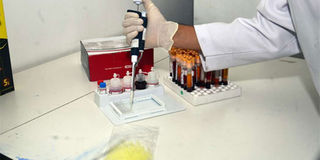Could science invent a ‘pregnancy’ test... for cars?

How hard can it be to devise a dipstick – perhaps as cheap and simple as a chemically-treated cotton bud – to test the purity of petrol or diesel? PHOTO | FILE | NATION MEDIA GROUP
What you need to know:
- How hard can it be to devise a dipstick – perhaps as cheap and simple as a chemically-treated cotton bud – to test the purity of petrol or diesel?
- It would be designed to react to the presence of kerosene which must surely contain – or could be laced with – something that petrol and diesel don’t have.
- Right now motorists don’t even glimpse the fuel that is put in their tank at the pump.
Modern technology can now detect and identify almost any substance, no matter how small the quantity or how “hidden” it might be.
Some of those tests require a high-tech research or forensic laboratory, and can take days or weeks... and an awful lot of skill and dollars. But many can now be done simply, easily and cheaply… in a matter of seconds.
Every schoolchild knows that white paper can be treated with a dye called “litmus” that has a happy habit of turning red in acidic conditions and blue in alkaline conditions.
So litmus is the basic, universal and ever-so-simple dipstick for assessing the pH (acid-alkaline spectrum) of just about anything.
TEST FLUIDS
So what? You do not need to know that litmus is extracted from a mossy lichen plant, nor what pH means (power of Hydrogen), or that the concept was introduced by a Danish chemist brewing Carlsberg beer in 1909, or that pH is the decimal logarithm of the reciprocal hydrogen ion activity in a solution.
You might not even know that the pH scale goes from 0 (very acidic) to 14 (very alkaline) with the mid-point 7 being neutral. But you should know that the pH of things is very important in farming, medicine, cosmetics, biology, chemistry, forestry, food and environmental science, oceanography, civil and chemical engineering, nutrition, water treatment and purification among many other applications.
And today, litmus is just one of many of concoctions that indicate (often by simply changing colour) when they encounter a substance they are designed to react to. Customs officers at airports have a whole collection of test fluids and swabs that can detect the smallest trace of drugs, and even give a colour-coded identification of which banned substance it is… in a matter of seconds.
It takes only fractionally longer for a woman to pop into the washroom and, with an equivalent test kit, to find out whether or not she is pregnant. Everything has a unique chemical fingerprint and there are other chemicals which can read it.
FUEL ADULTERATION
And, who knows, there might soon even be an App that will do the same thing. So how hard can it be to devise a dipstick – perhaps as cheap and simple as a chemically-treated cotton bud – to test the purity of petrol or diesel?
It would be designed to react to the presence of kerosene (as explained in this column two weeks ago) which must surely contain – or could be laced with – something that petrol and diesel don’t have. Right now motorists don’t even glimpse the fuel that is put in their tank at the pump.
Petrol stations might quite rightly object – on safety grounds – if motorists demanded a sample to test (in an open container in a busy forecourt). So if official double-check testing is not thorough, fuel can be adulterated with virtual impunity.
However, if science could produce a clever cotton bud, every motorist could have a box of them and the test could be done without anyone’s permission, without taking anyone’s time, by any – and potentially every – customer. In a blink.
If we added to that a hotline number that would call the techno-cavalry to the scene, and penalties for fuel adulteration that would turn the station owner’s bank balance red and his buttocks blue, fuel tampering would instantly stop. Completely.





